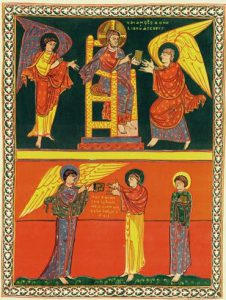 The honor of serving God before his throne is the first honor for the people of the New Jerusalem (22:3). Further honors occur in Revelation 22:4-5. Revelation 22:4 says, “And they will see his face, and his name will be on their foreheads.” Seeing God’s face is perhaps the greatest and most anticipated honor for the people of the New Jerusalem. Throughout the Bible, some of God’s greatest servants have been privileged with partial visions of God’s glory. One thinks immediately of Moses in Exodus 33:18-23, where God promises Moses a glimpse of his glory. Yet God tells Moses that he cannot see his face, because the one who sees God will die (Exod. 33:20, 23). Moses’ vision of God was so partial that John can confidently say, “No one has ever seen God” (John 1:18). Jesus later tells his disciples that to see him is to see the Father (John 14:9). In the context, Jesus appears to mean that to see him is to see as much of the Father as one can safely see prior to the New Jerusalem (John 14:7). He does pray, however, for his disciples that they would eventually join him where he is and see his glory (John 17:24). The people of the New Jerusalem will experience the answer to Jesus’ prayer. When they do, they will see the face of the Father and the Son shining forth in all of their glory, and yet they will not die.
The honor of serving God before his throne is the first honor for the people of the New Jerusalem (22:3). Further honors occur in Revelation 22:4-5. Revelation 22:4 says, “And they will see his face, and his name will be on their foreheads.” Seeing God’s face is perhaps the greatest and most anticipated honor for the people of the New Jerusalem. Throughout the Bible, some of God’s greatest servants have been privileged with partial visions of God’s glory. One thinks immediately of Moses in Exodus 33:18-23, where God promises Moses a glimpse of his glory. Yet God tells Moses that he cannot see his face, because the one who sees God will die (Exod. 33:20, 23). Moses’ vision of God was so partial that John can confidently say, “No one has ever seen God” (John 1:18). Jesus later tells his disciples that to see him is to see the Father (John 14:9). In the context, Jesus appears to mean that to see him is to see as much of the Father as one can safely see prior to the New Jerusalem (John 14:7). He does pray, however, for his disciples that they would eventually join him where he is and see his glory (John 17:24). The people of the New Jerusalem will experience the answer to Jesus’ prayer. When they do, they will see the face of the Father and the Son shining forth in all of their glory, and yet they will not die.
Both parts of Revelation 22:4 probably relate to the fulfillment of the priesthood. The first part indicates a contrast with the high priest of the Old Testament. He entered the Holy of Holies once a year on the Day of Atonement. When he did so, he had to do so with a cloud of incense that covered the mercy seat of the ark, or risk death (Lev. 16:13). His death would presumably be the result of seeing God too directly. The ark’s mercy seat is the place of God’s throne in the temple (2 Kgs. 19:15). As the antitype to the OT priests, the priestly servants of the New Jerusalem can approach God’s true throne and see God’s face. They wear the name of God on their foreheads (Rev. 22:4), which was unique to the high priest in the Old Testament (Exod. 28:36-38). The high priest was a unique servant of God with unique access to the Holy of Holies. In the New Jerusalem, all of God’s people are privileged servants of God with access to God’s throne that surpasses even that of the high priest.
Sources:
These paragraphs represent an edited portion of my book: Paul Hoskins, The Book of Revelation: A Theological and Exegetical Commentary, pp. 468-9.
